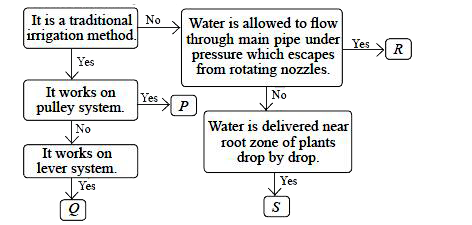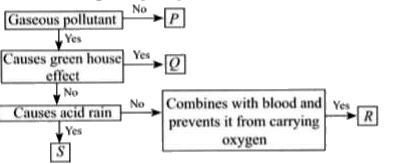Refer to the given dichotomous key and select the correct option regarding P, Q, R, S and T.
I. (a) Genetic material is not enclosed in nucleus. - Go to II
(b) Genetic material is enclosed in nucleus. - Go to III
II. (a) Lacks cell wall. - P
(b) Possesses cell wall. - Q
III. (a) Unicellular organism - R
(b) Multicellular organism - Go to IV
IV. (a) Plant body is sporophytic and water is required for fertilisation. - S
(b) Plant body is sporophytic and water is not required for fertilisation. - T
P is motile whereas Q is non-motile.
R could be yeast or Chlamydomonas.
Both S and T produce seeds for propagation of their species.
S could be Adiantum whereas T could be Riccia.
The correct Answer is:B
To solve the question regarding the classification of organisms P, Q, R, S, and T based on the given dichotomous key, we will follow the steps outlined in the key:
1. Identify the Genetic Material:
- The first question in the key asks if the genetic material is enclosed in a nucleus.
- If not enclosed, we proceed to step II.
- If enclosed, we proceed to step III.
2. Step II - Prokaryotes:
- Since we are considering the case where genetic material is not enclosed in a nucleus, we go to step II.
- In step II, we have two options:
- (a) If it lacks a cell wall, it is classified as P (this corresponds to Mycoplasma).
- (b) If it possesses a cell wall, it is classified as Q (this can correspond to Bacteria).
3. Step III - Eukaryotes:
- If the genetic material is enclosed in a nucleus, we proceed to step III.
- In step III, we have two options:
- (a) If it is a unicellular organism, it is classified as R (this could be a Protist or Yeast).
- (b) If it is a multicellular organism, we proceed to step IV.
4. Step IV - Multicellular Organisms:
- In step IV, we have two options:
- (a) If the plant body is sporophytic and water is required for fertilization, it is classified as S (this corresponds to Pteridophytes).
- (b) If the plant body is sporophytic and water is not required for fertilization, it is classified as T (this corresponds to Angiosperms).
Summary of Classifications:
- P: Mycoplasma (lacks cell wall, prokaryote)
- Q: Bacteria (possesses cell wall, prokaryote)
- R: Protist or Yeast (unicellular eukaryote)
- S: Pteridophyte (sporophytic, requires water for fertilization)
- T: Angiosperm (sporophytic, does not require water for fertilization)
- The first question in the key asks if the genetic material is enclosed in a nucleus.
- If not enclosed, we proceed to step II.
- If enclosed, we proceed to step III.
- Since we are considering the case where genetic material is not enclosed in a nucleus, we go to step II.
- In step II, we have two options:
- (a) If it lacks a cell wall, it is classified as P (this corresponds to Mycoplasma).
- (b) If it possesses a cell wall, it is classified as Q (this can correspond to Bacteria).
- If the genetic material is enclosed in a nucleus, we proceed to step III.
- In step III, we have two options:
- (a) If it is a unicellular organism, it is classified as R (this could be a Protist or Yeast).
- (b) If it is a multicellular organism, we proceed to step IV.
- In step IV, we have two options:
- (a) If the plant body is sporophytic and water is required for fertilization, it is classified as S (this corresponds to Pteridophytes).
- (b) If the plant body is sporophytic and water is not required for fertilization, it is classified as T (this corresponds to Angiosperms).
- P: Mycoplasma (lacks cell wall, prokaryote)
- Q: Bacteria (possesses cell wall, prokaryote)
- R: Protist or Yeast (unicellular eukaryote)
- S: Pteridophyte (sporophytic, requires water for fertilization)
- T: Angiosperm (sporophytic, does not require water for fertilization)
Topper's Solved these Questions
- BOOK - MTG IIT JEE FOUNDATIONCHAPTER - DIVERSITY IN LIVING ORGANISMSEXERCISE - EXERCISE (LONG ANSWER TYPE)25videos
DIVERSITY IN LIVING ORGANISMS
- BOOK - MTG IIT JEE FOUNDATIONCHAPTER - CELL-THE FUNDAMENTAL UNIT OF LIFEEXERCISE - OLYMPIAD/HOTS CORNER12videos
CELL-THE FUNDAMENTAL UNIT OF LIFE
- BOOK - MTG IIT JEE FOUNDATIONCHAPTER - FOOTSTEPS TOWARDS CBSE BOARD EXERCISE - SECTION D12videos
FOOTSTEPS TOWARDS CBSE BOARD
Similar Questions
Knowledge Check
- Question 1 - Select One
Refer to the given flow chart and select the correct option regarding P, Q, R and S.
 ADisease P is caused due to malfunctioning of exocrine glands while diseases Q, R and S are caused by pathogenic microbes.BS is a communicable disease while Q and R are non communicable diseases.CQ could be hepatitis B while R could be kala azar.DS could be sleeping sickness while R could be cholera.
ADisease P is caused due to malfunctioning of exocrine glands while diseases Q, R and S are caused by pathogenic microbes.BS is a communicable disease while Q and R are non communicable diseases.CQ could be hepatitis B while R could be kala azar.DS could be sleeping sickness while R could be cholera. - Question 2 - Select One
Refer to the given Venn diagram and select the correct option regarding P and Q.
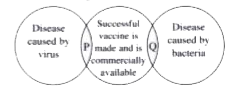 AP could be small pox whereas Q could be diphtheria.BP could be AIDS whereas Q could be malaria.CP could be common cold whereas Q could be whooping cough.DP could be typhoid whereas Q could be plague.
AP could be small pox whereas Q could be diphtheria.BP could be AIDS whereas Q could be malaria.CP could be common cold whereas Q could be whooping cough.DP could be typhoid whereas Q could be plague. - Question 3 - Select One
Refer to the given diagram of an animal cell and select the correct option regarding P and Q
 ASome of the vesicles of P store digestive enzymes obtained Q from Q in inactive state to form primary lysosomeBPolypeptides synthesised at Qare transported to P where they are modified into functional proteins for secretionCQ synthesises acrosome which plays an important role in the fertilisation process in humansDP is absent in pancreatic cells and cells of salivary glands whereas Q is absent in liver cells.
ASome of the vesicles of P store digestive enzymes obtained Q from Q in inactive state to form primary lysosomeBPolypeptides synthesised at Qare transported to P where they are modified into functional proteins for secretionCQ synthesises acrosome which plays an important role in the fertilisation process in humansDP is absent in pancreatic cells and cells of salivary glands whereas Q is absent in liver cells.
Refer to the given diagram of an animal cell and select the correct option regarding P and Q.
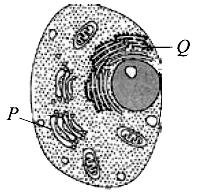 View Solution
View Solution
Refer to the given figure and select the correct option representing the osmolarity at P,Q,R and S.View SolutionRefer to the given diagram and select the correct option for the joints P, Q, R and S.
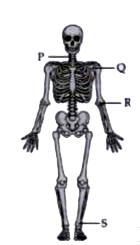 View Solution
View SolutionRefer to the given Venn diagram and select the correct statement regarding P, Q and R.
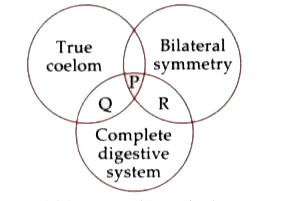 View Solution
View SolutionGenetic material found in cell is
View Solution


